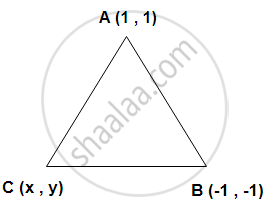Advertisements
Advertisements
प्रश्न
ABC is an equilateral triangle . If the coordinates of A and B are (1 , 1) and (- 1 , -1) , find the coordinates of C.
उत्तर

ABC is an equilateral triangle.
∴ AC = BC and AB = BC
⇒ AC2 = BC2 and AB2 = BC2
(x - 1)2 + (y - 1)2 = (x + 1)2 + (y + 1)2
⇒ x2 + 1 - 2x + y2 + 1 - 2y = x2 + 1 + 2x + y2 + 1+ 2y
⇒ - 4 x - 4y = 0
⇒ - 4 x = 4y
⇒ x = - y ...........(1)
(1 + 1)2 + (1 + 1)2 = (x + 1)2 + (y + 1)2
⇒ 8 = x2 + 1 + 2x + y2 + 1 + 2y
⇒ 8 = y2 + 1 + 2x + y2 + 1 + 2y
⇒ 2y2 - 6 = 0
⇒ y2 = 3
⇒ y = `+- sqrt 3`
From (1)
∴ x = `+- sqrt 3`
APPEARS IN
संबंधित प्रश्न
Find a relation between x and y such that the point (x, y) is equidistant from the point (3, 6) and (−3, 4).
Given a line segment AB joining the points A(–4, 6) and B(8, –3). Find
1) The ratio in which AB is divided by y-axis.
2) Find the coordinates of the point of intersection.
3) The length of AB.
Show that the quadrilateral whose vertices are (2, −1), (3, 4) (−2, 3) and (−3,−2) is a rhombus.
Find the distance of the following points from the origin:
(ii) B(-5,5)
Using the distance formula, show that the given points are collinear:
(6, 9), (0, 1) and (-6, -7)
Prove that the points (0,3) , (4,3) and `(2, 3+2sqrt 3)` are the vertices of an equilateral triangle.
Find the distance between the origin and the point:
(8, -15)
A point A is at a distance of `sqrt(10)` unit from the point (4, 3). Find the co-ordinates of point A, if its ordinate is twice its abscissa.
Prove that the points A (1, -3), B (-3, 0) and C (4, 1) are the vertices of an isosceles right-angled triangle. Find the area of the triangle.
Find distance between points O(0, 0) and B(– 5, 12)
